4 v 2 High/Low Drill
The 4 v 2 High/Low Drill is a nice activity for helping interior players become familiar with the rotations and various movements when partnering with another inside target. The 4 v 2 High/Low Drill is all about two interior players working together.
The 4 v 2 High/Low Drill starts with two perimeter players (Two and One) on each side of the floor in the foul line extended positions. These players cannot move initially, they can only skip pass the ball backwards and forwards.
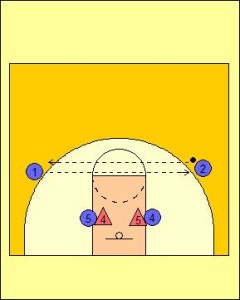
Just because One (1) and Two (2) cannot move does not mean they are allowed to make poor passes or not be in a good triple threat stance.
The object of the 4 v 2 High/Low Drill is for these perimeter players (One and Two) to skip the ball looking for an opportunity to pass into the interior targets of Four (4) and Five (5).
The Two defensive players assume good fundamental technical defensive positioning relevant to the coaches instructions and team philosophy to ensure the standard of play in the keyway is challenging and game realistic.
Once the ball is successfully passed into one of the post targets, the drill is “live”.
The ball can be passed back out of the post to the perimeter but this can only be undertaken a maximum of two times (this number can be varied at a coaches discretion) before the perimeter players must shoot. When this happens the drill now focuses on offensive and defensive rebounding.

The interior offensive players should look to implement High/Low principles into their play and try to generate good scoring opportunities through player movement into the high and low holes around the keyway.
An example of this might be when the ball is skipped across the keyway that the weak side low post player (Four) lifts into a high post position.
If the ball is passed into Four (4) then the drill becomes live as in any situation of the ball being passed into the keyway.
Points of Note:
- If Four (4) looks to drive at the basket on the same side to which Five (5) is standing. Five (5) will flare to the baseline mid-range ready to receive a short pass for the shot from Four (4).
- If Four (4) drives to the opposite side of the basket as Five (5). Then Five (5) will step towards the weak side of the backboard looking for the assist once Four (4) draws the help defence, or lift into a high post position and again looking for the pass back from Four (4).
- If Four (4) shoots, crash the boards
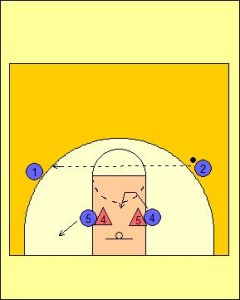
Another option is as the ball is skipped across the keyway is for Five (5) to flare to the mid-range on the baseline. This creates space for the other post player to work within.
In the example above, Four (4) fakes to lift into the high post position only to then dive towards the basket and into the better scoring position now that Five (5) has created some additional space.
Alternatively, Five (5) may receive the pass from One (1) then look to make the post entry pass into Four (4) who will now be on at the basket.
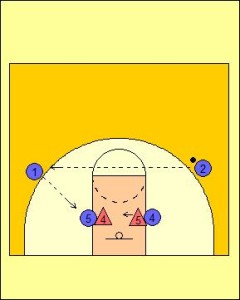
In the diagram above for the 4 v 2 High/Low Drill the ball has been skipped and then quickly passed into the post (Five).
In this picture we see that the off the ball defender has move closer to the ball and assumed a good help defence position.
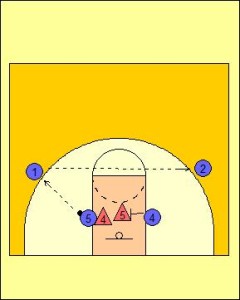
The ball is then passed out of the post only to be quickly skipped across the keyway.
As the ball is skipped, the weak side offensive post player (Four) seals into their defensive match-up who is on the split line in the earlier mentioned help position.
This tactic will be effective as long as a good seal has been established and performed early will result in good positioning at the basket for a very high percentage shot if the ball is able to be passed into the post.
This is a very effective strategy were the defensive team is over committing in help defence and looking to double a post player with the ball aggressively and early. With the help of a quick ball reversal, the alternative post can be in a very good scoring position.
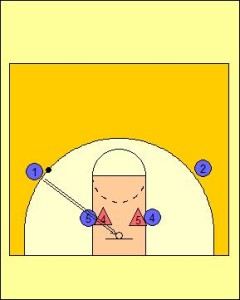
The final phase of the drill if the post players cannot score is for the perimeter players to shoot the ball.
This now forces the offensive players to initiate an offensive rebounding scenario.
The 4 v 2 High/Low Drill is very good for helping players become familiar with playing around each other in the keyway. It would not be unusual for players when first introducing the 4 v 2 High/Low Drill to be constantly crowding each other. This will especially be true when attacking the basket and the off the ball player is having to create space while still being a good passing option around the keyway.
Another very common problem seen in the early stages of implementation of the 4 v 2 High/Low Drill is the poor timing of the perimeter players in reading what is happening and what targets to look for. Most perimeter players tend to pass the ball too quickly when first experiencing the drill.




